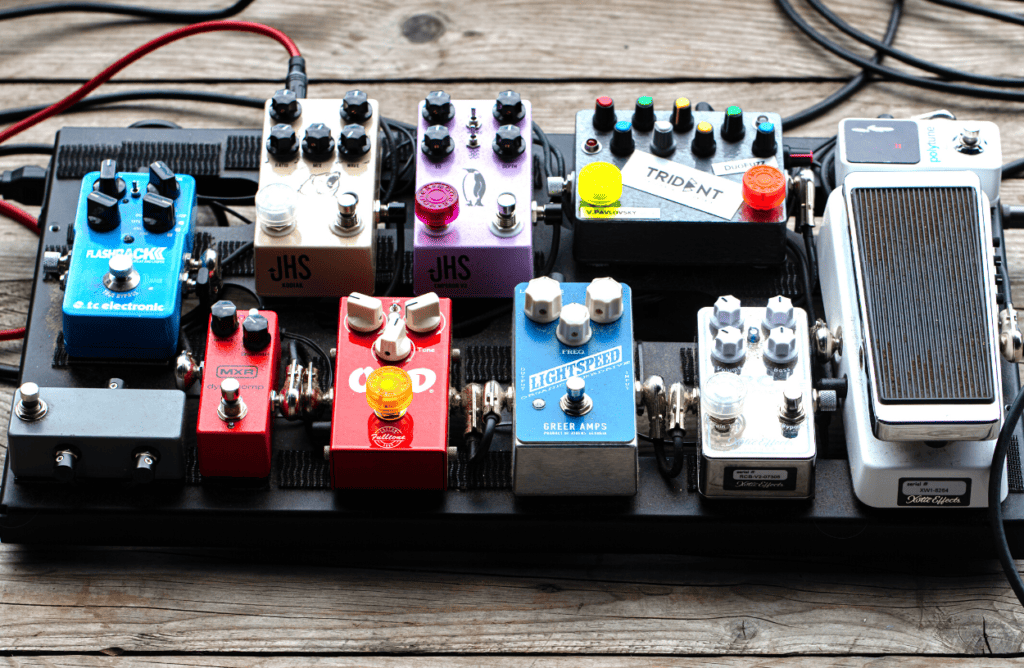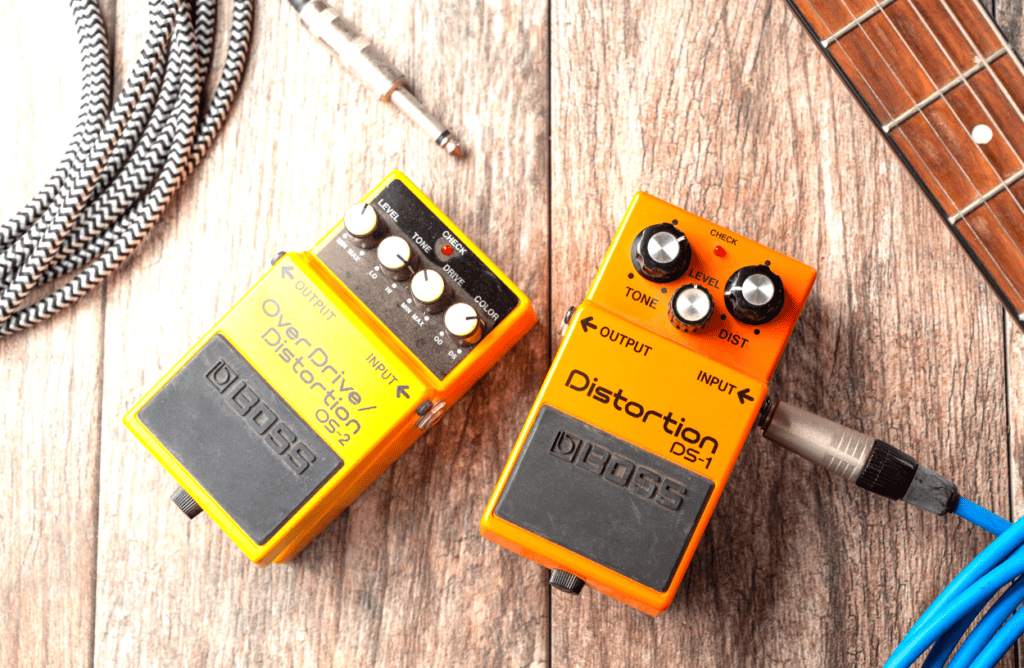Understanding the technical aspects of guitar pedals, particularly the distinctions between true bypass and buffered bypass, is essential for musicians looking to curate their sound efficiently.
The debate surrounding these two signal path alternatives has been going on in guitar communities and online forums for a long time.
This article aims to demystify the concepts of true and buffered bypass and break one of the oldest guitar myths, as well as explore their practical implications for your pedalboard and overall sound.

Table of Contents
What’s What
True Bypass
“True bypass” refers to a wiring method within guitar pedals that allows the signal from the instrument to pass through the pedal without interacting with its internal circuitry when the pedal is disengaged.
Essentially, the signal travels directly from the input to the output jack, bypassing the main circuit of the pedal, hence maintaining the original tonal quality of the instrument.
True bypass can be beneficial in certain contexts, especially within smaller pedal setups or shorter signal chains.
However, its efficacy and impact on tone can vary based on several factors, including cable length and the overall configuration of the pedalboard.
Examples of true bypass lines are Fender’s Hammertone, JHS 3 Series, and MXR pedals (including: EVH-117, Distortion III, and the Zakk Wylde overdrive.
Buffered Bypass
On the other hand, “buffered bypass” involves the signal interacting with a buffering circuit within the pedal, even when disengaged.
This buffering circuit is designed to preserve the strength and quality of the signal across longer cable runs and through multiple pedals.
While it can introduce a slight coloration to the tone, a buffered bypass can be crucial in maintaining signal integrity across extensive pedal chains or longer-stage setups.
The necessity and impact of a buffer within a signal chain can depend on various factors, such as the total cable length used, the number of pedals, and the specific pedals utilized.

Understanding the technicalities of buffered bypass, alongside its potential impact on a signal chain, facilitates informed decision-making regarding pedal choice and arrangement.
The best example of buffered bypass pedals is Boss pedals. Every single one of them, including Boss AW-3, BD-2, CE-5, and every Waza Craft pedal.
Main Differences Between True Bypass and Buffered Bypass
1. Signal Path Interaction
True bypass allows the signal to flow directly through the pedal, unaffected by its circuit when deactivated, whereas buffered bypass interacts with the signal constantly through its buffer.
2. Tone Preservation in Cable Lengths
In longer cable runs, true bypass may lose high-frequency sounds or “tone suck.” Buffered bypass assists in maintaining the signal strength and preventing such loss.
3. Impact on Signal Integrity
True bypass keeps the signal pure when the pedal is off, completely avoiding the pedal’s circuit. However, buffered bypass may color the tone slightly but offers other advantages like protecting against high-frequency loss.
4. Applicability in Pedal Chains
True bypass may be more beneficial in smaller pedal setups by maintaining signal purity. Buffered bypass can prevent tonal degradation for larger pedal chains and longer cables.
5. Context-Dependent Efficacy
Some fuzz and drive pedals may prefer the direct input that true bypass provides. In setups with long cables or numerous pedals, buffers may be vital.

6. Pop or Click Sounds Upon Activation
True bypass pedals sometimes produce a noticeable “pop” or “click” sound when activated, which can be disruptive in a live setting. Buffered bypass pedals, on the other hand, usually switch more quietly, preventing unwanted noise during performance.
7. Impact on Time-Based Effects
For time-based effects like reverb and delay, buffered bypass might ensure that the effect trails off naturally when switched off, whereas true bypass would cut it off abruptly.
8. Compatibility with Vintage Pedals
Certain vintage pedals, especially fuzz and certain wahs, are notorious for not playing well with buffers and might behave unpredictably or produce undesired tones when following a buffered bypass pedal.
9. Potential Impact on Dynamics
Some players observe that multiple buffers in a chain can slightly compress the signal, altering the dynamics. True bypass would not have this impact, maintaining the original signal dynamics.
10. Flexibility in Pedal Order
With true bypass, pedal order can be crucial, especially with certain effects like drive and fuzz. Buffered bypass pedals can sometimes provide more flexibility, as they drive the signal effectively through the chain, although they can interact unexpectedly with some pedal types.
11. Dependency on Power
Buffered bypass pedals require power to keep the buffer circuit active, even when the effect is disengaged. True bypass pedals do not need power for the signal to pass through when off, potentially preserving your tone in case of a power failure in your pedalboard.
The decision to choose between true bypass and buffered bypass would involve considering these factors and assessing the specific needs and contexts of your playing and pedalboard setup.
Ultimately, understanding these differences and experimenting with various configurations will guide you toward achieving your desired tone and signal quality.
So, What’s Better: True Bypass vs Buffered Bypass?
When it comes to the eternal debate of true bypass vs buffered bypass, there’s no definitive winner. Both options have strengths and weaknesses, and choosing between them largely depends on your specific needs and preferences.
True bypass is ideal if you have a minimal pedal setup, shorter cable runs, and want to keep your signal as pure as possible. It’s favored by players who prioritize maintaining the core tone of their guitar and amplifier.
However, it may not be the best choice for larger pedalboards or setups with numerous pedals and long cable lengths, as it can lead to high-frequency loss.
On the other hand, buffered bypass shines in scenarios where you have an extensive pedal chain, numerous true bypass pedals, or long cable runs.
Buffers can help preserve your tone, prevent signal degradation, and reduce the impact of cable capacitance. They are particularly useful for time-based effects like reverb and delay, ensuring smooth trails when the effect is turned off.
Finishing Thoughts
Choosing between true and buffered bypass involves a calculated consideration of your specific needs, playing context, and technical preferences.
Both bypass methods have their place in pedalboard design, offering different advantages based on the demands of your setup.
Your individual sound and technical requirements will ultimately determine the appropriate application of true and buffered bypass in your pedalboard setup, ensuring that your signal chain is optimized for your performance.